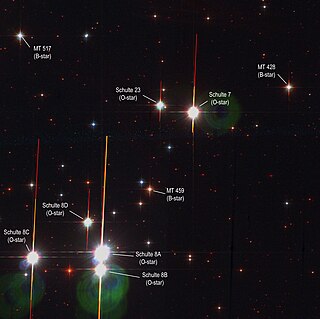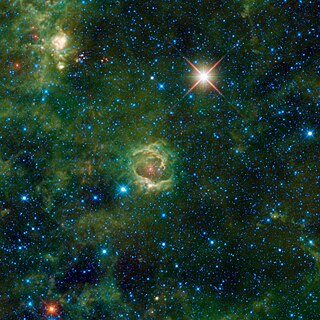
KY Cygni is a red supergiant of spectral class M3.5Ia located in the constellation Cygnus. It is approximately 4,700 light-years away.
KW Sagittarii is a red supergiant star, located approximately 2,160 parsecs away from the Sun in the direction of the constellation Sagittarius. It is one of the largest known stars, with a diameter about 1,000 times larger than the Sun. If placed at the center of the Solar System, the star's surface would engulf Mars, coming close to Jupiter's orbit.

V354 Cephei is a red supergiant star located within the Milky Way. It is an irregular variable located over 13,000 light-years away from the Sun. It has an estimated radius of 1,139 solar radii. If it were placed in the center of the Solar System, it would extend to between the orbits of Mars and Jupiter.

Cygnus OB2 #8A is a double-lined spectroscopic binary located near the centre of the Cygnus OB2 association located 5,500 light years away.

HD 74180 is a single star in the constellation Vela. It is a yellow-white F-type supergiant with a mean apparent magnitude of +3.81 and a spectral classification F8Ib. Estimates of its distance to Earth vary between 3,200 and 8,300 light-years.

S Persei is a red supergiant or hypergiant located near the Double Cluster in Perseus, north of the cluster NGC 869. It is a member of the Perseus OB1 association and one of the largest known stars. If placed in the Solar System, its photosphere would engulf the orbit of Jupiter. It is also a semiregular variable, a star whose variations are less regular than those of Mira variables.

NO Aurigae is a pulsating variable star in the constellation Auriga. It is an unusually-luminous asymptotic giant branch star about 3,500 light years away.

WOH G64 is an unusual red supergiant (RSG) star in the Large Magellanic Cloud (LMC) satellite galaxy in the southern constellation of Dorado. It is one of the largest known stars, being described as possibly being the largest star known. It is also one of the most luminous and massive red supergiants, with a radius calculated to be around 1,540 times that of the Sun (R☉) and a luminosity around 282,000 times the solar luminosity (L☉).

V602 Carinae is a red supergiant and variable star of spectral type M3 in the constellation Carina. It is considered to be one of largest known stars, being around 1,000 times larger than the Sun.

NML Cygni or V1489 Cygni is a red hypergiant or red supergiant (RSG) in the constellation Cygnus. It is possibly one of the largest known stars currently known, and is also possibly one of the most luminous and massive cool hypergiants, as well as one of the most luminous stars in the Milky Way.

PZ Cassiopeiae is a red supergiant star located in the constellation of Cassiopeia, and a semi-regular variable star.
AH Scorpii is a red supergiant variable star located in the constellation Scorpius. It is one of the largest stars known by radius and is also one of the most luminous red supergiant stars in the Milky Way.

31 Cygni, also known as ο1 Cygni, Omicron1 Cygni, ο2 Cygni or V695 Cygni, is a ternary star system about 750 light years away in the constellation Cygnus.

EV Carinae is a red supergiant and pulsating variable star of spectral type M4Ia in the constellation Carina. It is a semiregular variable star with its apparent magnitude varying between 7.4 and 9.0 in the visible band, making it only seen by binoculars or a telescope. Various periods have been identified, but the dominant one is around 347 days. It is an MK spectral standard star for the class M4.5Ia.

RW Cygni is a semiregular variable star in the constellation Cygnus, about a degree east of 2nd magnitude γ Cygni. Its apparent magnitude varies between 8.05 and 9.70 and its spectral type between M3 and M4.

BI Cygni(BI Cyg, IRC +40408, BD+36 4025) is a red supergiant in the constellation Cygnus. It is an irregular variable star with a maximum brightness of magnitude 8.4 and a minimum of magnitude 9.9. It is considered a member of the stellar Cygnus OB1 association, its distance is around 2,600 parsecs (8,500 ly) of the Solar System. It is less than a degree south of another variable red supergiant, BC Cygni.

BO Carinae, also known as HD 93420, is an irregular variable star in the constellation Carina.

IX Carinae is a red supergiant and pulsating variable star of spectral type M2Iab in the constellation Carina. It is a member of the Carina OB1 association along the Carina Nebula.

V1027 Cygni is a luminous yellow supergiant star located in the constellation of Cygnus, about 14,000 light years away. For a time, it was thought that it could be a low-mass post-AGB star, however recent parallax measurements published in Gaia DR3 have shown this to likely not be the case, and instead it is likely a massive yellow supergiant star.

AZ Cygni is a large red supergiant in the constellation of Cygnus. It is located 2,090 pc (6,800 ly) from Earth. It has been studied by the CHARA array in order to understand the surface variations of red supergiants.

















